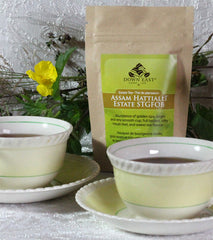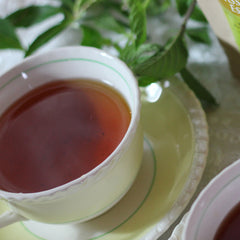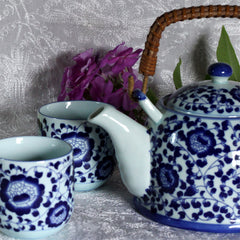GROWING
 The tea bush, Camellia Sinensis, is a good sized evergreen tree with dark glossy leaves and related to the garden camellia. In the wild, it reaches heights of about 30 ft. (10m) but the cultivated plant is constantly pruned to keep it down to at most 5 ft. (1.5m). This encourages leaf production and makes leaf plucking easier. Cultivation, however, is mostly from seed obtained from trees left to develop naturally.
The tea bush, Camellia Sinensis, is a good sized evergreen tree with dark glossy leaves and related to the garden camellia. In the wild, it reaches heights of about 30 ft. (10m) but the cultivated plant is constantly pruned to keep it down to at most 5 ft. (1.5m). This encourages leaf production and makes leaf plucking easier. Cultivation, however, is mostly from seed obtained from trees left to develop naturally.
Tea bushes grow successfully on acid soil with heavy rainfall, from the equator to the Black Sea coast of Russia and parts of northern China and Japan. It is grown from sea level up to mountainous 7000 ft. (2200 m). The best results are obtained at altitude above 4000 ft. (1200 m). It is believed that tea originated along the mountain forests along the border of Burma and India with China.
 Plucking is done by hand, despite many attempts to develop the right machinery. Every 7 to 14 days the bud and two end leaves are taken off each shoot: an experienced picker can gather up to 60 or even 70 lbs (27 to 32 kg) a day. In warmer climates (Sri Lanka, for instance) the bush will start yielding in its fourth year and harvesting can go on all year round, but at higher altitudes or in otherwise cooler regions, plants may need up to 10 years to mature, and plucking will be limited to a growing season. Producing life of a bush is at least 50 years.”
Plucking is done by hand, despite many attempts to develop the right machinery. Every 7 to 14 days the bud and two end leaves are taken off each shoot: an experienced picker can gather up to 60 or even 70 lbs (27 to 32 kg) a day. In warmer climates (Sri Lanka, for instance) the bush will start yielding in its fourth year and harvesting can go on all year round, but at higher altitudes or in otherwise cooler regions, plants may need up to 10 years to mature, and plucking will be limited to a growing season. Producing life of a bush is at least 50 years.”
Our teas: BLACK | GREEN | WHITE
PROCESSING
It is in the method of processing that leaves produce the characteristics of each tea. Processing is carried out as soon as possible after the harvest and nearly always on the estate. The manufacturing of tea is now highly mechanized; machines carry out the labour-intensive tasks of rolling and sieving the leaves.
There are several tasks and stages essential to making the tea leaves ready for consumption:
- Withering – the newly plucked leaves are spread on trays and fresh or heated air is directed over them for up to 24 hours; the leaves will lose about 40 % of their weight.
- Rolling – breaks up the leaf cells, releasing the essentials oils and enzymes.
- Sieving – vibrating sieves separate the finer leaves from the coarser elements, which are then rolled and sieved again.
- Fermenting – the full process of oxidization in a humid atmosphere usually takes no more than 4 hours. During this time the colour of the tea will change to a rusty brown. For green tea, much used in China and Japan, the fermenting stage is skipped altogether. Tea fermented only for a very short while is known as oolong.
- Firing – hot air is used to halt fermentation of tea and ready it for storage and transportation.
GRADING
Grading defines tea qualities and the most important grades are:
Leaf Tea:
- Flowerey Orange Pekoe = FOP
- In Darjeeling also Golden Flowery Orange Pekoe = GFOP and Tippy Golden Flowery Orange Pekoe = TGFOP.
- This refers to a thin, wiry leaf with tips. Tips are the golden or silver-coloured, visible leaf tips (buds), which contain less tannin and, hence, do not darken during the fermentation. They indicate young tealeaves were used; however, this is not necessarily a determinate of exceptional quality.
- A long, wiry leaf, larger than the FOP. The meaning of the term is unknown. Orange refers to to Dutch "Oranje', which mean "royal".
- Ceylon low-grown" Pekoes have a ball-shaped leaf. Pekoes are stronger in the infusion than Orange Pekoe because the latter contains more leaf ribs and less “flesh”.
Fannings and Dust:
- These are the smallest parts of the leaf, without the stem or ribs, which are collected during the sieving. Fannings and dust are high yielding, strong, colour the cup quickly and hence, are preferred for use in tea bags.
BREWING
 A general rule for caffeine-containing tea varieties: Infusion for up to 3 minutes has a stimulation effect and then over 3 minutes, a calming effect.
A general rule for caffeine-containing tea varieties: Infusion for up to 3 minutes has a stimulation effect and then over 3 minutes, a calming effect.
Standard black tea: freshly boiled water with temperatures above 95°C (203°F).
Green tea and white tea: filtered water, freshly boiled and left to cool for at least 30 seconds. Alternatively the water heated to reach recommended temperatures between 74°C to 85°C (160°F to 203°F).
Shop our loose leaf premium teas: BLACK | GREEN | WHITE
